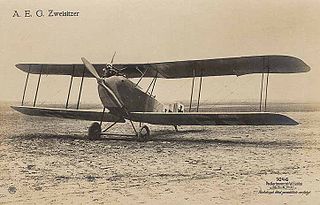
The AEG C.IV was a two-seat biplane reconnaissance aircraft designed and produced by the German aircraft manufacturer Allgemeine Elektrizitäts-Gesellschaft.
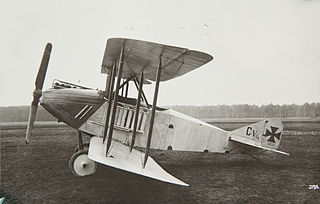
The AEG C.V was a prototype two-seat biplane reconnaissance aircraft of World War I. Designed to use a more powerful engine than previous AEG C-class reconnaissance aircraft, results were disappointing enough that further development was cancelled.

The AEG G.IV was a biplane bomber aircraft designed and produced by the German aircraft manufacturer Allgemeine Elektrizitäts-Gesellschaft. It saw action during the First World War with the Luftstreitkräfte.

The AEG J.I was a German biplane ground attack aircraft designed and produced by the German aircraft manufacturer Allgemeine Elektricitäts-Gesellschaft. It was a mission-specific derivative of the AEG C.IV reconnaissance aircraft.

The Albatros C.III was a twin-seat general-purpose biplane designed and produced by the German aircraft manufacturer Albatros Flugzeugwerke. It was produced in greater numbers than any other C-type aircraft by Albatros as well as being the company's most-produced twin-seat aircraft.

The Albatros C.I,, was a twin-seat general-purpose biplanes designed and produced by the German aircraft manufacturer Albatros Flugzeugwerke. It was the first of the successful C-series aircraft operated by the Luftstreitkräfte.

The Albatros B.II, was an unarmed two-seat reconnaissance biplane designed and produced by the German aircraft manufacturer Albatros Flugzeugwerke. It was the aircraft that brought Albatros Flugzeugwerke to the world's attention.

The Pfalz D.III was a fighter aircraft used by the Luftstreitkräfte during the First World War. The D.III was the first major original design from Pfalz Flugzeugwerke. Though generally considered inferior to contemporary Albatros and Fokker fighters, the D.III was widely used by the Jagdstaffeln from late 1917 to mid-1918. It continued to serve as a training aircraft until the end of the war.

The AGO C.IV was a German biplane reconnaissance aircraft designed and produced by the German aircraft manufacturer AGO Flugzeugwerke. It was active with the Luftstreitkräfte during the latter half of the First World War.

The Albatros C.VII was a military reconnaissance aircraft designed and produced by the German aircraft manufacturer Albatros Flugzeugwerke. It was a revised and re-engined development of the Albatros C.V, which had proved disappointing in service.

The Albatros C.X was a German military reconnaissance aircraft that saw service during World War I.

The Halberstadt CL.IV was a German ground attack aircraft of World War I.
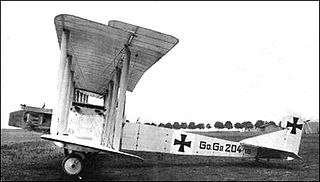
The Gotha G.II series was a heavy bomber used by the Luftstreitkräfte during World War I.
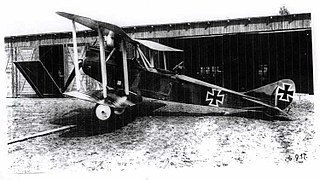
The Rumpler C.IV was a German single-engine, two-seat reconnaissance biplane. It was a development of C.III with different tail surfaces and using a Mercedes D.IVa engine in place of the C.III's Benz Bz.IV. The Rumpler 6B 2 was a single-seat floatplane fighter variant with a 120 kW (160 hp) Mercedes D.III engine built for the Kaiserliche Marine.

The LVG C.II was a 1910s German two-seat reconnaissance biplane designed at the Luft-Verkehrs-Gesellschaft for the Luftstreitkräfte.
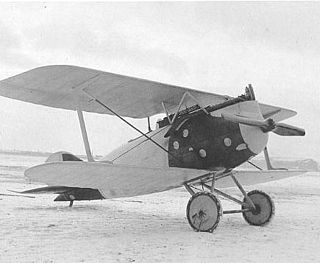
The Rumpler D.I was a fighter-reconnaissance aircraft produced in Germany at the end of World War I. It was a conventional single-bay biplane with wings of unequal span braced by I-struts. It featured an open cockpit and a fixed, tailskid undercarriage. The upper wing was fitted with aerodynamically balanced ailerons and fuselage had an oval cross-section.
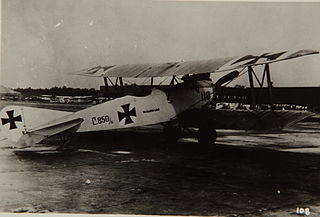
The Albatros C.IV,. was a German military reconnaissance aircraft built in the autumn of 1915 by Albatros Flugzeugwerke. It was a single-engined biplane, and was based on the Albatros C.III, with which it shared many parts. It was eventually abandoned, in favour of the C.V.

The LFG Roland D.XV was a World War I German single seat fighter aircraft, ordered as a test-bed for engine comparisons. It was distinguished from earlier Roland biplane designs by the elimination of flying wires. Two later aircraft, also called LFG Roland D.XV, were completely different designs with slab sided fuselages.
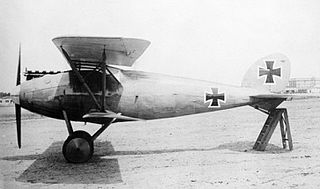
The Albatros C.XIII was a German two-seat, single-engine, biplane light fighter aircraft built in 1917. Only one was constructed.

The Albatros C.XIV was a German two seat, single engine, biplane fighter aircraft built in 1918. Only one was constructed.





















